Genre: Platformer Developer: Arc Development Publisher: US Gold Players: 1 Released: 1994
The Hurricanes was a short-lived cartoon about a football team. From what I gather online a tame, indistinct one, whose characters of the “young adult” variety were too old for their cautious adventures and hence their audience. The show’s hyper-hygienic, personality-free drawing style smacks of recent Christian entertainment, by which I mean later than C.S. Lewis, regardless of whether there’s any connection between its style and purpose the style would be enough to put off quite a few “young adults”, a suitably vague and nonsensical term given the show’s unfocused appeal. It’s not surprising the cartoon was short lived, and mystifying perhaps that it received a video game translation, but in the long run origins are immaterial.
Also released on the Game Gear and Super Nintendo, it was created by Arc Development and published by US Gold, the same partnership that brought an unwilling gaming public Johnny Bazookatone. It’s also culpable for Bart vs. the Space Mutants on the Genesis. It was a division of Probe. The SNES version, released in Europe and the US, is simply credited to Probe; more in line with the above games’ quality, it’s a distant departure from the Mega Drive version.
The plot is delivered by a newscaster in exhortative segments between the rather ill-defined sections of the game. These are no more than a series of updates about why you’re fighting through your present scenery. The essential premise is that the Gorgons, a rival team, are owned by some unscrupulous magnate or mafioso who’ll stop at nothing to stop our very own do-gooders. So the team’s first task is to board their airplane despite the goons running about doing sinister things with its fuel in an airport. Yes, there are some weird locales, and it’s hard to keep track of them all since news updates don’t come at regular intervals and there are often several athematic subsections to each stage. For instance, reaching that initial airport requires hoofing it through some jungle—the actual first stage is home to flying squirrels and armadillos.
Our team is composed of three males (white, black, Chinese) and a tritely perky blonde. Your guess is as good as mine as to where the other seven mates are off to. Even on the title screen there are three other members who aren’t available for selection unless a very doubtful code exists. Unfortunately, all play identically, and there is no sort of background or alternative narrative for any of them. This is especially disappointing since players can be exchanged at set points—what in a game with more definite level and plot partitions could be called chapters. Enemies tend to be animals or people, neither of which would typically strike one as dangerous outside video game logic. Watch out! It’s a flying squirrel! Quick, get inside here comes a skateboarder! …Erm, sure. But, not to be outdone, you the player character are armed with a football. Black and white checkered death!
It’s an endearing mechanic. Video game weapons are almost always fired from the hip and above, and then usually without any influence of trajectory. The ball can be kicked straight across the ground, chipped forward knee high, or punted upwards at about a 60-degree angle either soft or hard (hard is sort of a double click); it can also be kicked whilst jumping with the same variety. It then bounces and rolls as one would expect and sits on screen till one engages it with one’s feet or one leaves the screen, which later will cause it to be hurled back to the player character from the foreground, a nicely animated sequence. That animation also occurs after the ball rolls into a pit or is punctured by a surly porcupine. Ball separation is gently enforced, there are very few instances you’ll be more than a couple seconds without it. Kicking it short at a boss and consequently having to retrieve it from beside him is the biggest hazard one will
face. The Hurricanes could have been a very intriguing game had one to recover one’s ball from wherever it rested but this would have made it quite challenging and probably too methodical. Here and there our footballers will encounter a coloured bin into which the ball can be kicked, resulting in a power-up whose effect frankly will be too brief to impact more than one or two dealings with enemies.
Which leads us to the game’s challenge level. Pretty mild but not quite so gentle as I feel the developers intended. That feeling stems from the forgivingly loose stage layouts and common health-ups, along with the bosses’ relatively low HP. What make it trickier are the occasional need to find some sort of unhinted key and more often a certain style of offscreen jump that I hesitate to term blind—it’s more in the nature of an educated guess. Difficulty selection alters the number of initial credits: Easy supplies three, Normal one, Hard zero; more can be found throughout the game in the form of a blue and white badge. Bosses deal more damage on Hard but that seems the only meaningful difference (credits won’t be needed unless you’re trying to complete the game your first try). I’ve not verified whether the game can be finished on Easy. Each setting provides four lives; losing one conjures a floating referee who hands out a yellow card, or if it’s game over a red. Flags exist as respawn points. They aren’t progressive, meaning that if you touch one far into a level but have to backtrack (or fall) and touch an earlier one and then die, that’s the one at which you’ll reappear. This is on account of the occasionally needed key item and the exit’s tendency to be nooked away somewhere rather than placed at some linear finish line. The exit is a gold badge; touch it and you’re done.
One quirk that must be kept in mind is that although depleting your life bar results in a standard “lose one life and respawn” cycle, healing your health beyond your life bar reaps an extra life. This is something that you may not want, because that extra life is not fully healed. It comes with the surplus health you just restored. So, if you have 4-UP at 80% life and eat something worth 40% health you’ll be promoted to 5-UP at 20% health, meaning you’re about to die, and if you’re far from your last checkpoint that could be a problem. Some bosses also count as checkpoints.
Levels are of moderate size taken left to right but always involve extensive vertical exploration. Whilst the Hurricanes jump well vertically, they can’t grab ledges, so reaching that next platform above you is likely to mean navigating a series of platforms or an incline that can only be accessed from its grounding point. In jungle areas this will mean traversing gap-toothed bridges and sharp hills; indoors this will mean racing up escalators (with a ball? magic footwork) and hopping about improbable floor plans. A few locations involve vertical shafts and lifts. No, not terribly diverse or original, but solid fare for platformer fans. The Hurricanes run well and can take a lot of punishment so many areas can be breezed through once you know the main layout. One thing though, it’s long. Nothing incredible but an unwarned player might be surprised more than once that the stage he’s just completed doesn’t lead to the final boss.
Despite its length, The Hurricanes is a light, friendly game. From the beginning it doesn’t feel like a campaign, the construction and challenge level don’t invite perfectionism, and the mood is perky without enough cartoon material to make it annoying. Obviously, this owes a lot to the theme and the funky “weapon” employed, but the graphics and music hold up their end as well. Songs are recycled in accordance with any given stage’s basic theme. We have one with a primitive sound for the jungle, another vaguely Caribbean for sunnier climes, a jazzy techno tune for modern spaces, and a couple others that are less memorable. None are remarkable but all are pleasant, there will be no stabbing at the mute button for this game. The recording quality is good. Sound effects are repetitive, and a couple of them are too loud but mostly discreet, as they should be. For instance, hearing every rebound a football makes would’ve been maddening.
The visuals are better yet. Though low in detail, they’re very crisp: bright where they should be, dark where they should be, always distinct. Design quality varies by stage theme, with jungles being the best, and whilst all backdrops are low on detail, foreground objects are mixed in and the important sprites are well animated. Our team runs and kicks nimbly, and the ball bounces as it should. Above that there’s a soft sense of whimsy. Gorillas, warthogs, porcupines, hounds, aboriginals, skateboarders, motorcyclists, cops, goons, rival footballers, and many random objects all appear a little detached, as if they know they’re supposed to harm you but don’t sincerely want to do it. It wouldn’t be this type of cartoon if they were all slavering yellow eyed murder. For example, one of the last levels is a great amorphous shower room replete with obstacles and tenacious foes…which due to the game’s appearance and tone feels like the Mentos rendition of Alien 3’s infirmary. The cut scenes at the TV station are too cheesy for my taste, but they’re easily ignored, and the art style, potentially grating in a cartoon full of constant close ups, becomes pleasant enough in a game where only one character sprite is on screen at a time and most of the enemies aren’t even human.
Engrish enthusiasts will find a few misspellings despite the game’s non-Japanese roots.
If the mechanic appeals to you, then it’s worth investigating. If you’re the hardcore collector type, and it’s just another shelf filler you’ve bought since you already own it, you might as well give it a try. Or if you’re a Genesis fan with a child who has exhausted Disney and Sonic, a child you don’t want to have hate you the rest of your life for giving him Garfield or Rocky and Bullwinkle, this might be a nice surprise. In the grand scheme of gaming, I can’t say it’s the brightest light, but it’s pleasant and easy and just different enough to warrant a 6/10.
SCORE: 6 out of 10

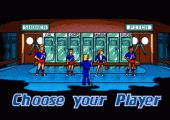
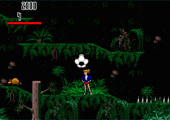
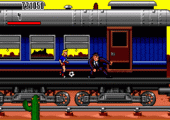
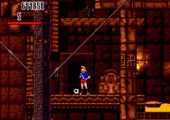
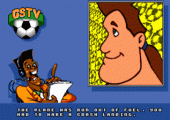
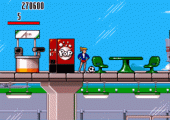
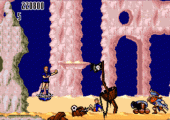
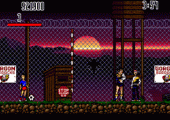
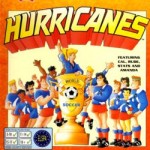
Recent Comments